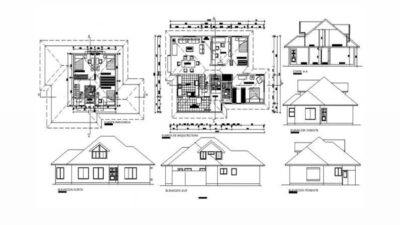Do you possess a deep passion for crafting and constructing structures that leave an indelible mark on our ever-evolving world? Embarking on the journey to become an architect in the vibrant state of Illinois offers a profoundly gratifying and enriching career pathway. Whether your aspirations involve envisioning towering skyscrapers, crafting intimate residential abodes, or crafting inviting public spaces, this comprehensive guide shall serve as your trusted companion, meticulously guiding you through the indispensable phases required to realize your architectural dreams within the dynamic realm of the Land of Lincoln.
Step 1: Embark on Your Architectural Journey with a Bachelor’s Degree
Embarking on your path to becoming a renowned architect in Illinois starts with the foundational step of earning a Bachelor’s degree. This crucial educational phase equips you with the essential knowledge and skills that will form the bedrock of your architectural career. Here’s a detailed breakdown of how to kickstart your journey:
- Choose the Right Program: Opt for a Bachelor’s degree program in architecture or a closely related field. It’s vital to ensure that the program you select is accredited by the National Architectural Accrediting Board (NAAB). This accreditation guarantees that you’ll receive a high-quality education that adheres to industry standards;
- Curriculum Insights: Over the span of approximately 5 years, your bachelor’s program will immerse you in a rich tapestry of architectural education. This includes in-depth explorations into design theory, architectural history, mathematics, and building technology. You’ll learn how to create not just aesthetically pleasing structures but also structurally sound and sustainable ones.
Tips for Success: To excel in your studies, consider the following tips:
- Cultivate a strong foundation in mathematics, as it plays a fundamental role in architectural calculations;
- Dive deep into architectural history to draw inspiration from past masters and diverse design styles;
- Keep up with the latest advancements in building technology to stay relevant in the ever-evolving field of architecture.
Step 2: Shape Your Skills through Practical Experience
Your journey toward becoming a licensed architect in Illinois doesn’t stop with a bachelor’s degree; it requires practical experience to refine your craft. Here’s how to gain valuable hands-on knowledge and expertise:
- Internship or Apprenticeship: Securing an internship or apprenticeship position is pivotal in your career development. In Illinois, the primary avenue for acquiring practical experience is through the Intern Development Program (IDP). This program places you under the guidance and mentorship of a licensed architect, allowing you to apply classroom knowledge in real-world scenarios;
- Accumulating Work Hours: To meet the requirements set forth by the Illinois Architecture Practice Act, you’ll need to accumulate a specific number of work hours. Typically, this entails completing around 3,740 hours of practical experience. These hours will expose you to a myriad of architectural projects, from residential designs to large-scale commercial endeavors.
Unlocking the Benefits: Practical experience offers you a host of benefits beyond just fulfilling regulatory requirements:
- Enhance your design skills by working on diverse projects under the supervision of experienced architects;
- Develop crucial teamwork and communication skills as you collaborate with other professionals in the field;
- Gain insight into the practical aspects of architecture, including project management, budgeting, and client interactions.
Step 3: Elevate Your Expertise with a Master’s Degree
While not obligatory, embarking on the journey towards a Master of Architecture (M.Arch) degree can be a pivotal move to supercharge your architectural career. This advanced degree transcends the basics and propels you into the realm of architectural mastery. Here’s why you should consider it:
- Broaden Your Horizons: A Master’s program delves deeper into architectural theory, design principles, and innovative technologies. It equips you with a broader perspective, enabling you to think beyond conventional boundaries;
- Enhanced Career Opportunities: In the fiercely competitive architecture job market, a master’s degree can set you apart. Many employers, especially those in prestigious firms or specialized niches, prefer candidates with this advanced qualification;
- Specialization Opportunities: Master’s programs often offer the chance to specialize in areas like sustainable design, historic preservation, or urban planning. This specialization can open doors to exciting, niche career opportunities;
- Research and Innovation: If you’re passionate about pushing the boundaries of architectural knowledge, a master’s degree can facilitate research projects and experimentation. You could contribute to groundbreaking architectural innovations;
- Networking and Collaborations: Your fellow students and professors in a Master’s program can become invaluable connections in the industry. Collaborative projects and exposure to diverse ideas can fuel your growth.
To make the most of your pursuit of a Master’s in Architecture:
- Research programs carefully: Look for institutions known for their architectural programs and choose one that aligns with your interests;
- Seek scholarships or financial aid: Tuition costs for master’s degrees can be significant, so explore options for funding;
- Network actively: Attend industry events, join architectural organizations, and connect with professionals in your desired specialization.
Step 4: Conquer the Architect Registration Examination (ARE)
Becoming a licensed architect in Illinois hinges on passing the Architect Registration Examination (ARE). This rigorous examination evaluates your proficiency in various facets of architecture, ensuring you possess the skills and knowledge needed for the role. Here’s an in-depth look:
The ARE Exam Sections:
- Practice Management: Covers the business aspects of architecture, including ethics, project management, and legal responsibilities;
- Project Management: Focuses on project planning, design, and delivery, with an emphasis on contract management and project evaluation;
- Programming and Analysis: Tests your ability to gather and assess project requirements and constraints, ensuring they align with client needs;
- Project Planning and Design: Evaluates your design and integration skills, including site and environmental analysis, building systems, and codes;
- Project Development and Documentation: Assesses your ability to translate designs into technical documents, specifications, and contract administration;
- Construction and Evaluation: Covers construction observation, quality control, and project closeout.
Tips for Success in ARE:
- Start Early: Begin your exam preparations well in advance to allow sufficient time for comprehensive studying;
- Use Study Materials: Invest in ARE study guides, online courses, and practice exams to familiarize yourself with the exam format and content;
- Create a Study Schedule: Organize your study time effectively, allocating dedicated periods for each exam section;
- Join Study Groups: Collaborate with fellow ARE candidates to share insights, study resources, and motivation;
- Practice Time Management: The ARE has a time limit for each section, so practice completing questions within the allocated time;
- Take Care of Your Health: Maintain a healthy lifestyle during your preparation, including regular breaks, exercise, and adequate sleep;
- Simulated Exam Conditions: Mimic exam conditions when practicing to build stamina and reduce anxiety on test day.
Step 5: Fulfilling Illinois State Licensing Requirements
Once you’ve successfully conquered the Architect Registration Examination (ARE), the journey to becoming a licensed architect in Illinois enters a new phase. The Prairie State has its own unique set of requirements that you must diligently navigate to achieve your goal. Here’s a comprehensive breakdown of what you need to do:
1. Background Check:
- Illinois doesn’t take licensing lightly. You’ll need to undergo a thorough background check to ensure your suitability for practicing architecture in the state;
- This process involves scrutinizing your criminal record, if any, as well as your professional history. Be prepared to provide all the necessary documentation related to your past work and any legal matters.
2. Interview with IDFPR:
- The Illinois Department of Financial and Professional Regulation (IDFPR) will require you to participate in an interview;
- This is not a mere formality; it’s an opportunity for them to assess your knowledge, ethical standards, and understanding of the state’s specific architectural requirements;
- It’s crucial to be well-prepared for this interview, as it can greatly influence your licensing outcome.
3. Documentation Submission:
- Complying with paperwork is a key aspect of this step. Carefully review the state’s licensing requirements and ensure you’ve gathered all the necessary documentation;
- Be meticulous in preparing your application to avoid delays or complications in the licensing process.
4. Patience and Perseverance:
- Obtaining your architectural license in Illinois may not happen overnight. It’s essential to be patient and persistent throughout this phase;
- Stay in regular communication with the relevant authorities, and be proactive in addressing any issues or questions that may arise during the application process.
5. Seek Guidance:
Consider reaching out to experienced architects who have successfully navigated the Illinois licensing process. They can provide valuable insights and advice to help you succeed.
Step 6: Continuing Education for Licensed Architects
Becoming a licensed architect is an impressive achievement, but it’s not the end of the road. In Illinois, and indeed in the dynamic field of architecture, staying current and continuously expanding your knowledge is paramount. Here’s how you can do just that:

1. Fulfill Continuing Education Requirements:
- As a licensed architect in Illinois, you are required to participate in ongoing continuing education to maintain your professional competency;
- The state mandates a certain number of continuing education hours or credits within a specified timeframe.
2. Stay Informed:
- Keep a vigilant eye on industry trends, innovations, and updates. Subscribe to architectural publications and websites to stay in the loop;
- Attend architectural conferences, seminars, and workshops to network with peers and gain fresh insights.
3. Explore Specializations:
- Architecture is a diverse field, and specialization can open new avenues in your career. Consider focusing on areas such as sustainable design, healthcare architecture, or historic preservation, depending on your interests.
4. Mentorship and Collaboration:
Engage in mentorship programs or collaborate with seasoned architects. Learning from experienced professionals can be incredibly enriching and can help you broaden your skillset.
5. Maintain Professional Memberships:
Join and actively participate in professional organizations like the American Institute of Architects (AIA). These groups often offer educational resources, networking opportunities, and events that contribute to your ongoing development.
6. Embrace Technology:
Architecture is increasingly reliant on technology. Stay proficient in architectural software and tools to remain competitive and relevant in the industry.
Step 7: Launching Your Architectural Career in Illinois
Congratulations! You’ve now equipped yourself with the essential building blocks for your architectural journey in Illinois. Armed with your education, hands-on experience, and the necessary licensure, it’s time to set your architectural dreams into motion. You have two exciting paths ahead: either seek employment with a well-established architectural firm or venture into the world of entrepreneurship by starting your very own practice.
Expanding Your Horizons in Architecture
Entering the architectural field in Illinois opens up a world of possibilities. Here’s how to make the most of your career launch:
- Seeking Employment:
- Research Architectural Firms: Take the time to explore architectural firms in Illinois. Investigate their specialties, work culture, and reputation within the industry;
- Prepare a Stellar Portfolio: Your portfolio is your calling card. Compile a diverse selection of your best work to showcase your skills and creativity;
- Network: Attend architectural events, conferences, and job fairs to connect with potential employers. Building a strong professional network can lead to valuable job opportunities.
- Starting Your Practice:
- Business Plan: Craft a detailed business plan that outlines your architectural niche, target clientele, and financial projections;
- Legal Considerations: Navigate the legal requirements for starting a business in Illinois. This includes registering your practice, obtaining necessary permits, and adhering to local regulations;
- Funding: Explore funding options such as personal savings, loans, or grants to kickstart your architectural practice;
- Marketing Strategy: Develop a robust marketing strategy to attract clients. This may involve creating a website, utilizing social media, and building a brand identity;
- Workspace: Secure a suitable workspace, whether it’s a home office or a physical studio location;
- Insurance: Protect your practice with professional liability insurance and other necessary coverage.
Step 8: Thrive Through Professional Organizations
To truly excel in your architectural career in Illinois, consider becoming an active member of professional organizations such as the American Institute of Architects (AIA) or the Illinois Council of the American Institute of Architects (AIA Illinois). These associations are your gateway to a plethora of opportunities and resources:
Benefits of Joining Professional Organizations:
- Networking: Connect with a diverse community of architects, industry experts, and potential clients. Forge valuable professional relationships that can open doors to collaborations and projects;
- Continuing Education: Stay updated with the latest trends, technologies, and best practices in architecture through workshops, seminars, and webinars organized by these organizations;
- Advocacy: Be a part of initiatives that advocate for architectural excellence, sustainability, and the advancement of the profession;
- Recognition: Professional organizations often recognize outstanding architects and projects, providing you with opportunities for accolades and exposure;
- Mentorship: Seek guidance and mentorship from seasoned architects who can offer valuable insights and help you navigate the challenges of your career;
- Access to Resources: Gain access to a wealth of resources, including research materials, design tools, and publications, to enrich your architectural knowledge;
- Read about the path to your dream career with our guide to obtaining a Texas architecture license. Get started today!
Conclusion
Attaining the title of an architect within the state of Illinois demands unwavering commitment, a comprehensive educational background, and substantial hands-on experience. By diligently adhering to these essential stages and maintaining steadfast dedication to your aspirations, you can forge a prosperous path in the field of architecture. Your contributions will play a pivotal role in shaping and building the distinctive and lively communities that define Illinois. Keep in mind that the voyage towards becoming an architect is demanding, yet the gratification of witnessing your visionary designs manifest into reality is unquestionably worth the endeavor.











